A Microwave Photonics True-Time-Delay System Using Carrier Compensation Technique Based on Wavelength Division Multiplexing
Abstract
:1. Introduction
2. Principle
3. Simulation Results
4. Experimental Results
4.1. Experimental Setup
4.2. Optical Spectrum
4.3. Electrical Spectrum
4.4. Time Domain Results
5. Discussion
6. Conclusions
Author Contributions
Funding
Informed Consent Statement
Data Availability Statement
Acknowledgments
Conflicts of Interest
References
- Longbrake, M. True Time-Delay Beamsteering for Radar. In Proceedings of the 2012 IEEE National Aerospace and Electronics Conference (NAECON), Dayton, OH, USA, 25–27 July 2012; IEEE: Manhattan, NY, USA, 2012; pp. 246–249. [Google Scholar]
- Capmany, J.; Novak, D. Microwave Photonics Combines Two Worlds. Nat. Photon. 2007, 1, 319–330. [Google Scholar] [CrossRef]
- Rotman, R.; Tur, M.; Yaron, L. True Time Delay in Phased Arrays. Proc. IEEE 2016, 104, 504–518. [Google Scholar] [CrossRef]
- Jung, B.-M.; Shin, J.-D.; Kim, B.-G. Optical True Time-Delay for Two-Dimensional X-Band Phased Array Antennas. IEEE Photon. Technol. Lett. 2007, 19, 877–879. [Google Scholar] [CrossRef]
- Wang, J.; Hou, P.; Cai, H.; Sun, J.; Wang, S.; Wang, L.; Yang, F. Continuous Angle Steering of an Optically- Controlled Phased Array Antenna Based on Differential True Time Delay Constituted by Micro-Optical Components. Opt. Express 2015, 23, 9432. [Google Scholar] [CrossRef] [PubMed]
- Ding, Z.; Yang, F.; Cai, H.; Weng, Y.; Wang, M.; Wang, D. Photonic Radio Frequency Memory with Controlled Doppler Frequency Shift. In Proceedings of the 2019 International Topical Meeting on Microwave Photonics (MWP), Ottawa, ON, Canada, 7–10 October 2019; IEEE: Manhattan, NY, USA, 2019; pp. 1–3. [Google Scholar]
- Nguyen, T.A.; Chan, E.H.W.; Minasian, R.A. Photonic Radio Frequency Memory Using Frequency Shifting Recirculating Delay Line Structure. J. Light. Technol. 2014, 32, 99–106. [Google Scholar] [CrossRef]
- Qi, K.; Zhang, Y.; Wu, Y.; Li, H.; Yuan, P. Tunable and Flat Optical Delay Line Based on Double Rings Resonators. In Quantum and Nonlinear Optics IV, Proceedings of the SPIE/COS Photonics Asia, Beijing, China, 3 November 2016; Gong, Q., Guo, G.-C., Ham, B.S., Eds.; SPIE: Bellingham, WA, USA, 2016; p. 1002916. [Google Scholar]
- Khurgin, J.B.; Morton, P.A. Tunable Wideband Optical Delay Line Based on Balanced Coupled Resonator Structures. Opt. Lett. 2009, 34, 2655. [Google Scholar] [CrossRef] [PubMed]
- Brunetti, G.; Conteduca, D.; Dell’Olio, F.; Ciminelli, C.; Armenise, M.N. Design of an Ultra-Compact Graphene-Based Integrated Microphotonic Tunable Delay Line. Opt. Express 2018, 26, 4593. [Google Scholar] [CrossRef] [PubMed]
- Zhang, Q.; Ji, J.; Cheng, Q.; Duan, Y.; Zang, J.; Yang, J.; Yu, H.; Zhang, X. Two-Dimensional Phased-Array Receiver Based on Integrated Silicon True Time Delay Lines. IEEE Trans. Microw. Theory Tech. 2022, 1–11. [Google Scholar] [CrossRef]
- Moreira, R.L.; Garcia, J.; Li, W.; Bauters, J.; Barton, J.S.; Heck, M.J.R.; Bowers, J.E.; Blumenthal, D.J. Integrated Ultra-Low-Loss 4-Bit Tunable Delay for Broadband Phased Array Antenna Applications. IEEE Photon. Technol. Lett. 2013, 25, 1165–1168. [Google Scholar] [CrossRef] [Green Version]
- Sancho, J.; Bourderionnet, J.; Lloret, J.; Combrié, S.; Gasulla, I.; Xavier, S.; Sales, S.; Colman, P.; Lehoucq, G.; Dolfi, D.; et al. Integrable Microwave Filter Based on a Photonic Crystal Delay Line. Nat. Commun. 2012, 3, 1075. [Google Scholar] [CrossRef] [PubMed]
- Zhang, W.; Yao, J. A Fully Reconfigurable Waveguide Bragg Grating for Programmable Photonic Signal Processing. Nat. Commun. 2018, 9, 1396. [Google Scholar] [CrossRef] [PubMed] [Green Version]
- Liu, J.; Cheng, T.H.; Yeo, Y.K.; Wang, Y.; Xue, L.; Zhu, N.; Xu, Z.; Wang, D. All-Optical Continuously Tunable Delay with a High Linear-Chirp-Rate Fiber Bragg Grating Based on Four-Wave Mixing in a Highly-Nonlinear Photonic Crystal Fiber. Opt. Commun. 2009, 282, 4366–4369. [Google Scholar] [CrossRef]
- Cheng, T.-H.; Liu, J.; Yeo, Y.; Wang, Y.; Xu, Z.; Wang, D. Hi-Fi All-Optical Continuously Tunable Delay with a High Linear-Chirp-Rate Fiber Bragg Grating Based on Four-Wave Mixing in a Highly-Nonlinear Photonic Crystal Fiber. In Proceedings of the Optical Fiber Communication Conference and National Fiber Optic Engineers Conference, San Diego, CA, USA, 22–26 March 2009; p. JWA31. [Google Scholar]
- Pisco, M.; Campopiano, S.; Cutolo, A.; Cusano, A. Continuously Variable Optical Delay Line Based on a Chirped Fiber Bragg Grating. IEEE Photon. Technol. Lett. 2006, 18, 2551–2553. [Google Scholar] [CrossRef]
- Zhao, J.; Ding, Z.; Yang, F.; Cai, H. Configurable Photonic True-Time Delay Line Based on Cascaded Linearly Chirped Fiber Bragg Grating. In Proceedings of the 2018 International Topical Meeting on Microwave Photonics (MWP), Toulouse, France, 22–25 October 2018; IEEE: Manhattan, NY, USA, 2018; pp. 1–4. [Google Scholar]
- Italia, V.; Pisco, M.; Campopiano, S.; Cusano, A.; Cutolo, A. Tunable Optical True Time Delay Line Based on Fiber Bragg Grating. In Proceedings of the 2005 IEEE/LEOS Workshop on Fibres and Optical Passive Components, Palermo, Italy, 22–24 June 2005; IEEE: Manhattan, NY, USA, 2005; pp. 345–348. [Google Scholar]
- Ball, G.A.; Glenn, W.H.; Morey, W.W. Programmable Fiber Optic Delay Line. IEEE Photon. Technol. Lett. 1994, 6, 741–743. [Google Scholar] [CrossRef]
- Molony, A.; Zhang, L.; Williams, J.A.R.; Bennion, I.; Edge, C.; Fells, J. Fiber Bragg-Grating True Time-Delay Systems: Discrete-Grating Array 3-b Delay Lines and Chirped-Grating 6-b Delay Lines. IEEE Trans. Microw. Theory Tech. 1997, 45, 1527–1530. [Google Scholar] [CrossRef]
- Zhang, C.; Liao, P.; Burgoyne, B.; Kim, Y.; Trepanier, F.; Villeneuve, A.; Liboiron-Ladouceur, O. Low-Cost Dispersion-Tuned Active Harmonic Mode-Locked Laser With a 3-Cm Coherence Length. IEEE J. Select. Top. Quantum Electron. 2014, 20, 399–405. [Google Scholar] [CrossRef]
- Morton, P.A.; Khurgin, J.B.; Morton, M.J. All-Optical Linearized Mach-Zehnder Modulator. Opt. Express 2021, 29, 37302. [Google Scholar] [CrossRef] [PubMed]
- Inui, T.; Komukai, T.; Nakazawa, M.; Suzuki, K.; Tamura, K.R.; Uchiyama, K.; Morioka, T. Adaptive Dispersion Slope Equalizer Using a Nonlinearly Chirped Fiber Bragg Grating Pair with a Novel Dispersion Detection Technique. IEEE Photon. Technol. Lett. 2002, 14, 549–551. [Google Scholar] [CrossRef]
- Lanne, S.; Penninckx, D.; Thiery, J.-P.; Hamaide, J.-P. Impact of Chirping on Polarization-Mode Dispersion Compensated Systems. IEEE Photon. Technol. Lett. 2000, 12, 1492–1494. [Google Scholar] [CrossRef]
- Dong, B.; Wei, L.; Zhou, D.P. Coupling Between the Small-Core-Diameter Dispersion Compensation Fiber and Single-Mode Fiber and Its Applications in Fiber Lasers. J. Light. Technol. 2010, 28, 1363–1367. [Google Scholar] [CrossRef]
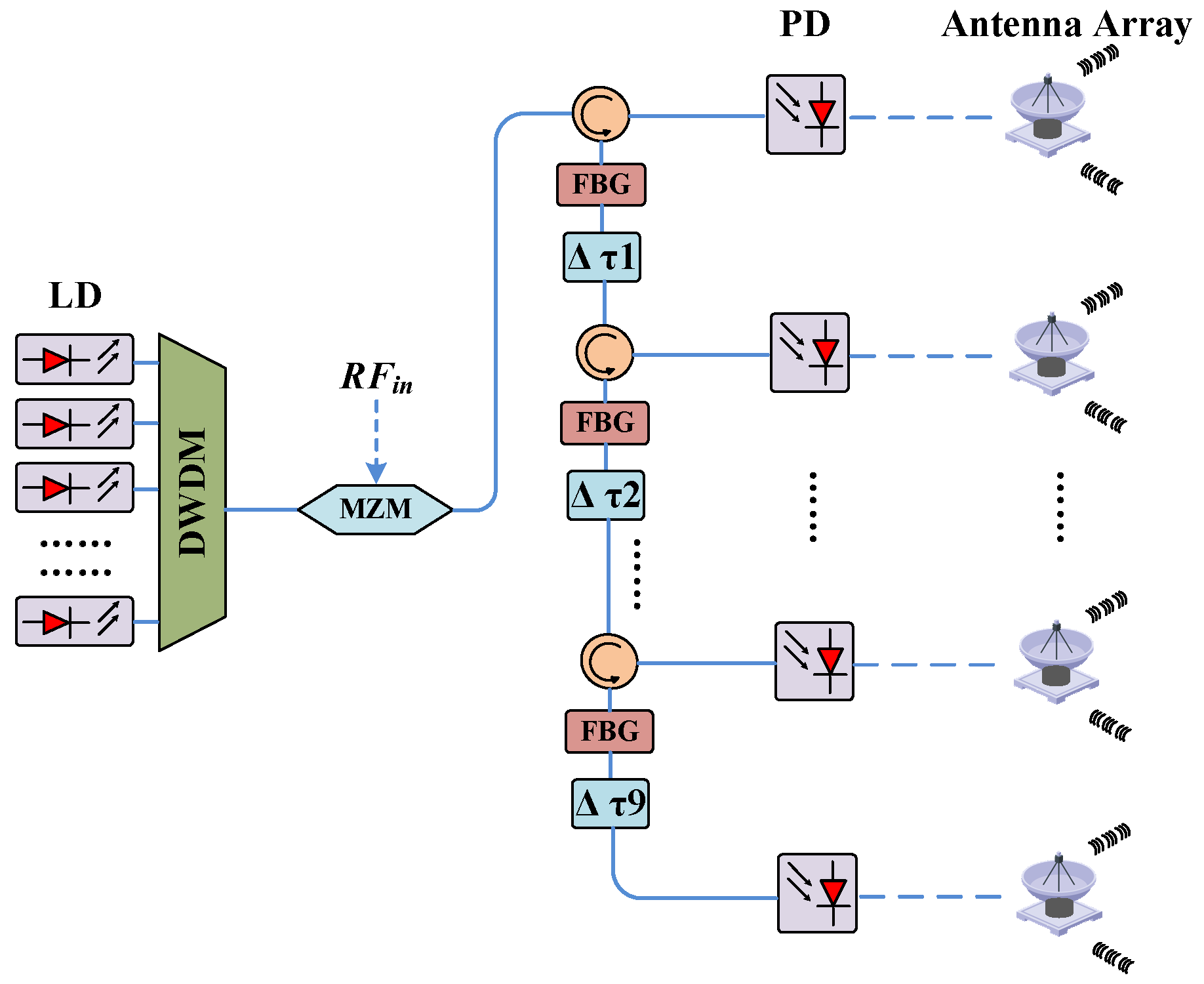
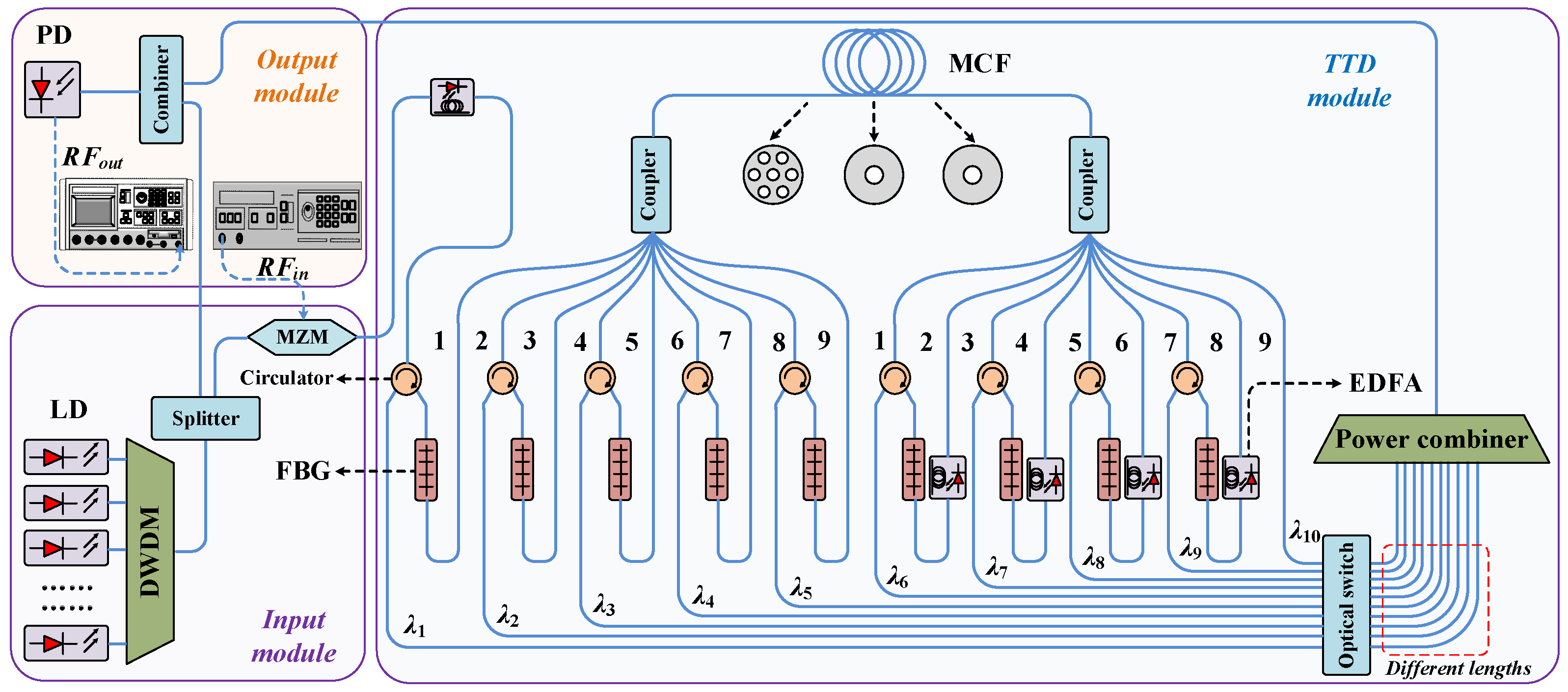

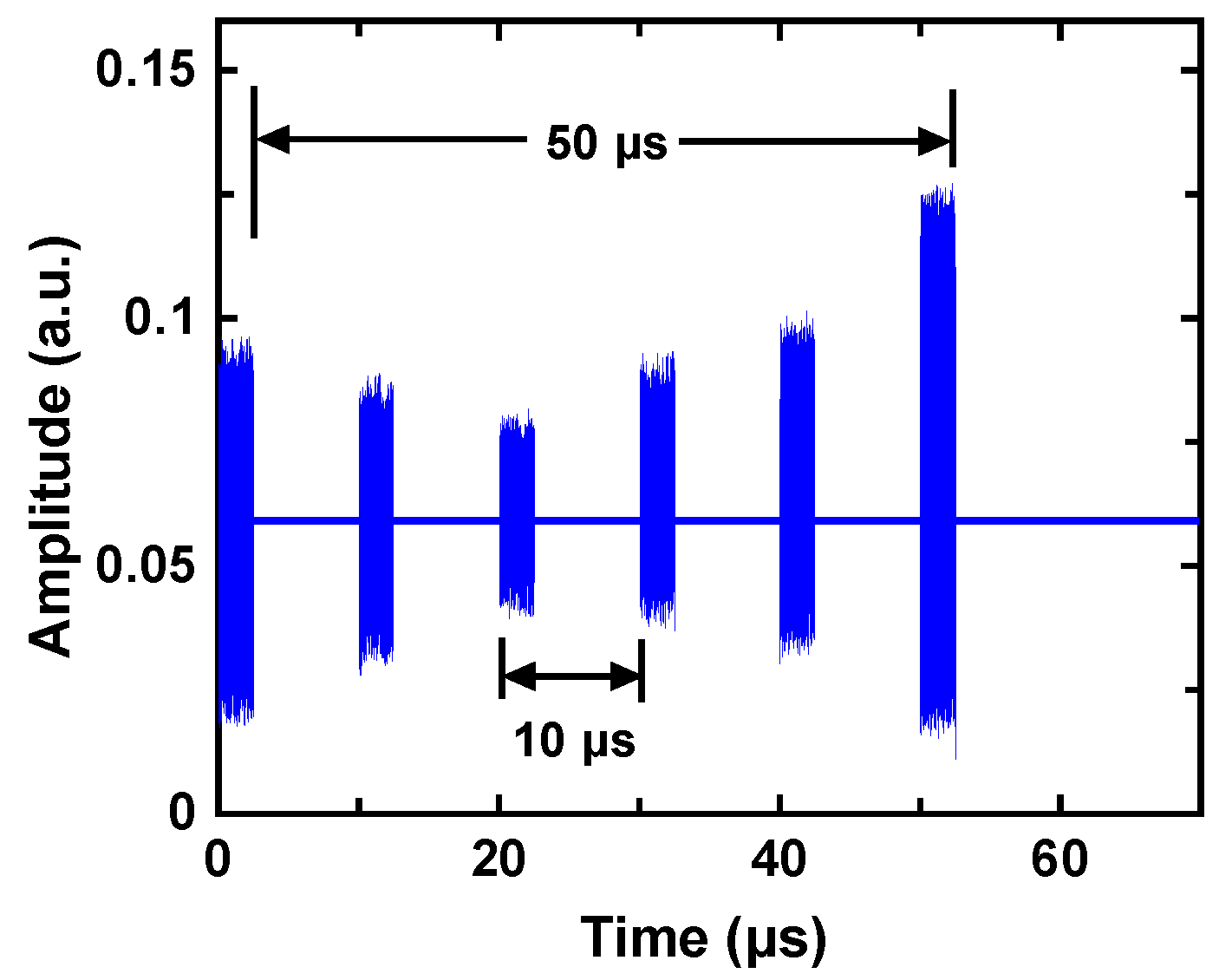

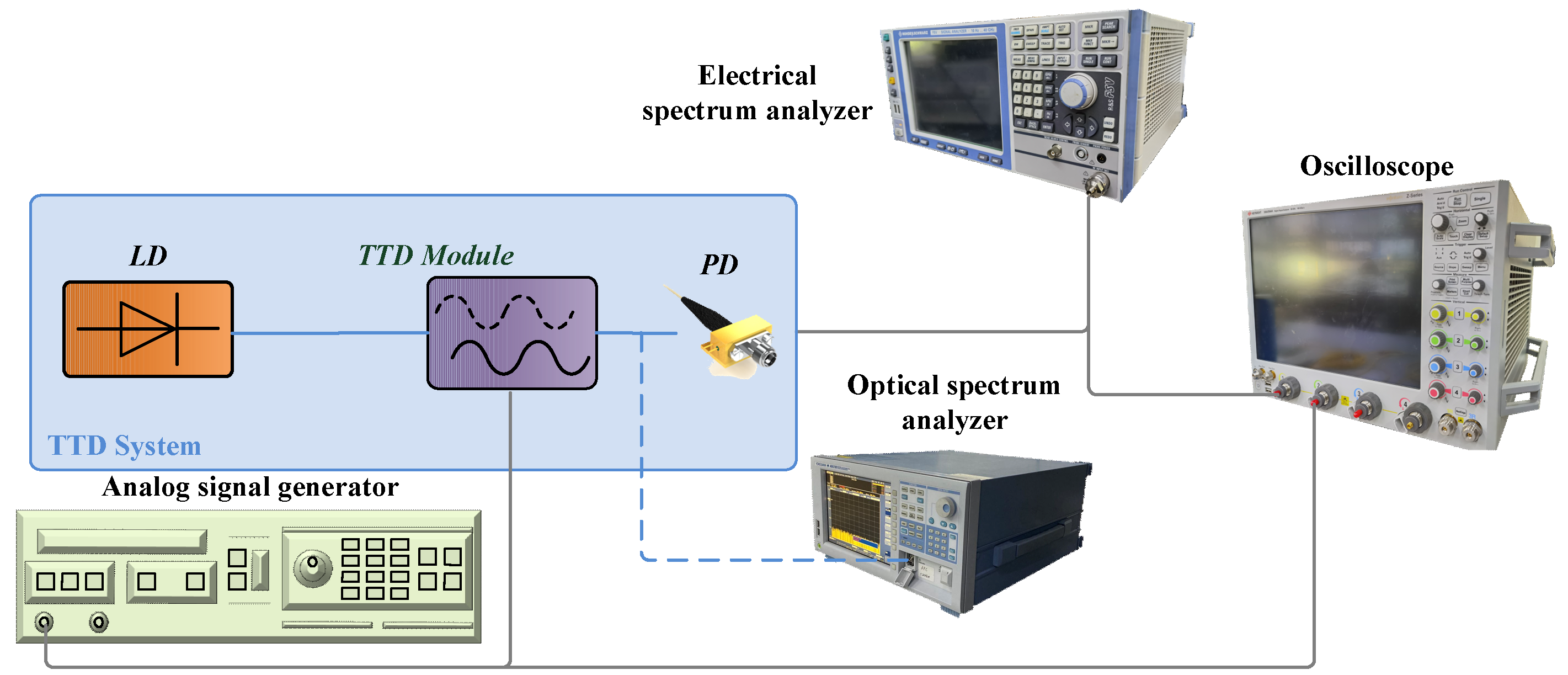

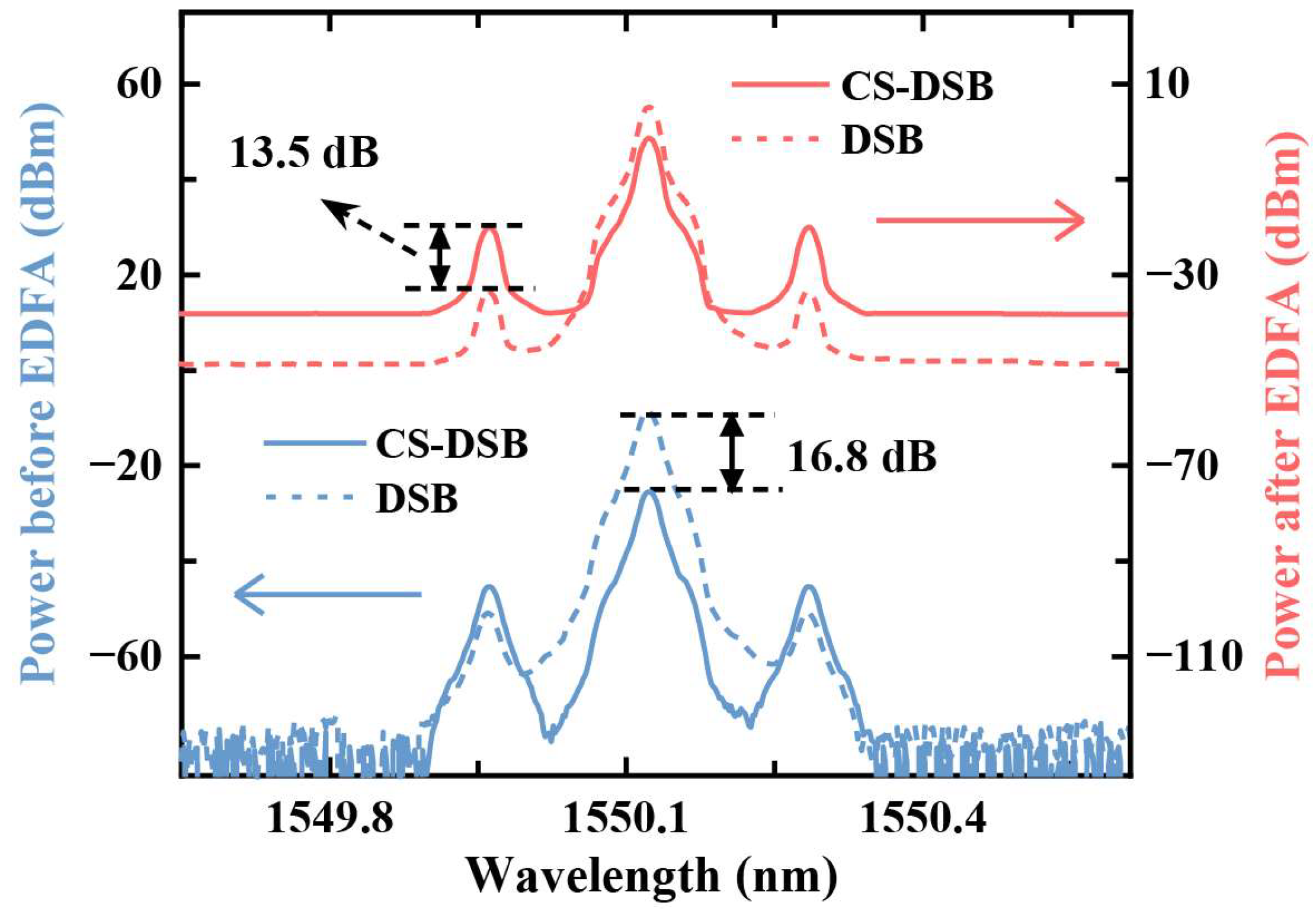
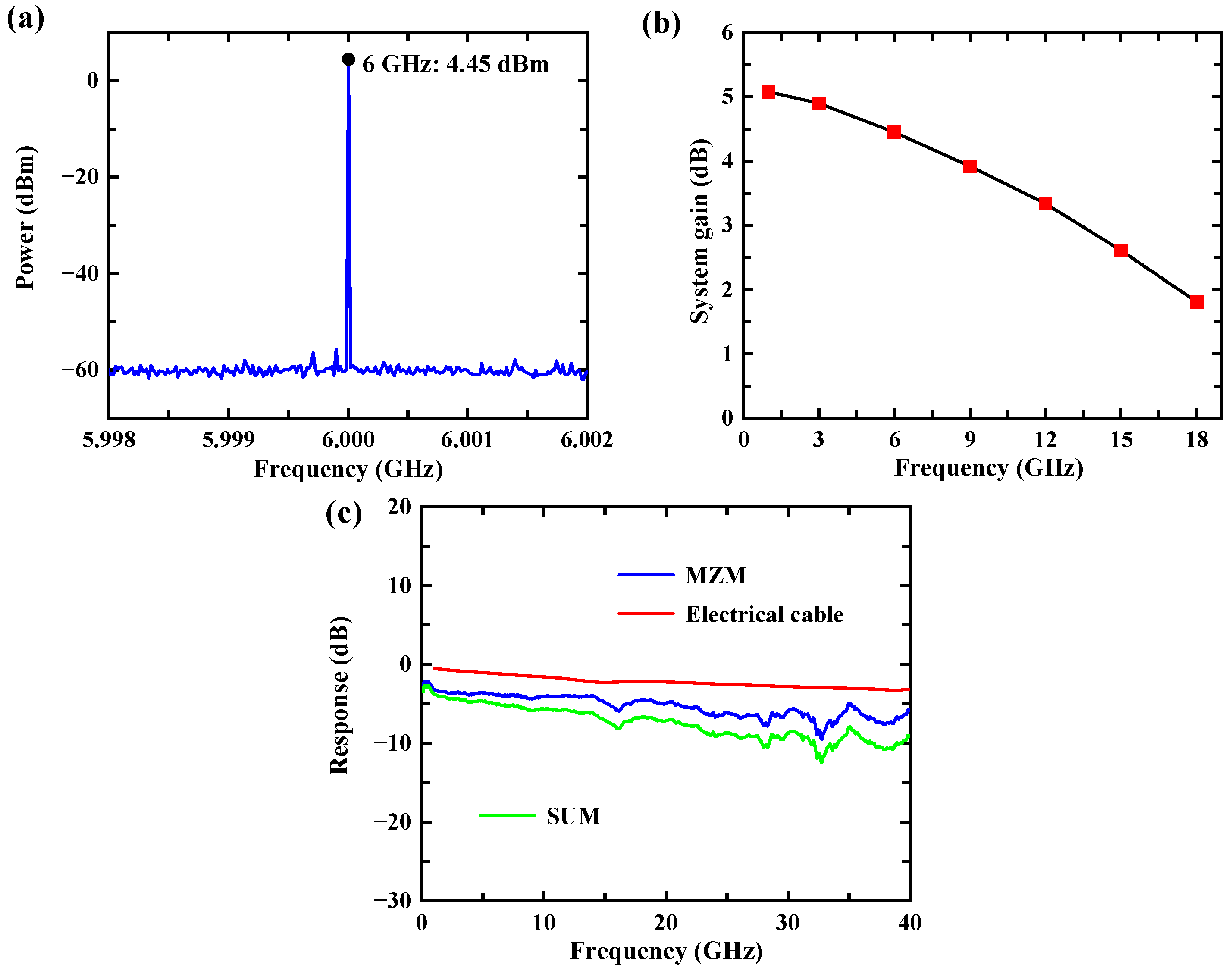

| Abbreviations | Meaning |
|---|---|
| LD | Laser diode |
| DWDM | Dense wavelength division multiplexer |
| MZM | Mach–Zehnder modulator |
| EDFA | Erbium-doped fiber amplifier |
| PD | Photodetector |
| MCF | Multi-core fiber |
Disclaimer/Publisher’s Note: The statements, opinions and data contained in all publications are solely those of the individual author(s) and contributor(s) and not of MDPI and/or the editor(s). MDPI and/or the editor(s) disclaim responsibility for any injury to people or property resulting from any ideas, methods, instructions or products referred to in the content. |
© 2022 by the authors. Licensee MDPI, Basel, Switzerland. This article is an open access article distributed under the terms and conditions of the Creative Commons Attribution (CC BY) license (https://creativecommons.org/licenses/by/4.0/).
Share and Cite
Zhao, Y.; Wang, C.; Zhao, Z.; Zhang, W.; Liu, J. A Microwave Photonics True-Time-Delay System Using Carrier Compensation Technique Based on Wavelength Division Multiplexing. Photonics 2023, 10, 34. https://doi.org/10.3390/photonics10010034
Zhao Y, Wang C, Zhao Z, Zhang W, Liu J. A Microwave Photonics True-Time-Delay System Using Carrier Compensation Technique Based on Wavelength Division Multiplexing. Photonics. 2023; 10(1):34. https://doi.org/10.3390/photonics10010034
Chicago/Turabian StyleZhao, Yiru, Chaoquan Wang, Zeping Zhao, Weijie Zhang, and Jianguo Liu. 2023. "A Microwave Photonics True-Time-Delay System Using Carrier Compensation Technique Based on Wavelength Division Multiplexing" Photonics 10, no. 1: 34. https://doi.org/10.3390/photonics10010034
APA StyleZhao, Y., Wang, C., Zhao, Z., Zhang, W., & Liu, J. (2023). A Microwave Photonics True-Time-Delay System Using Carrier Compensation Technique Based on Wavelength Division Multiplexing. Photonics, 10(1), 34. https://doi.org/10.3390/photonics10010034





